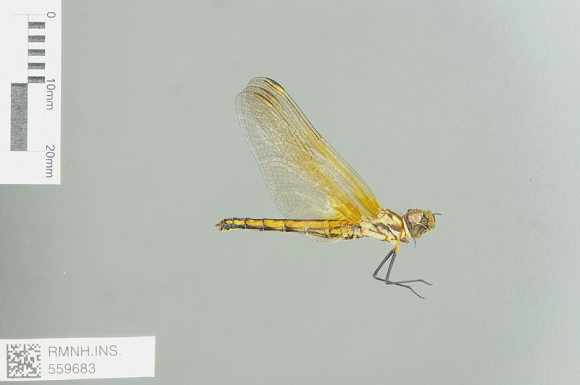Trithemis pluvialis Förster, 1906
Russet Dropwing
Type locality: Lake Tanganyika, Tanzania
Diagnosis
Male is similar to T. annulata by (a) labrum at least partly pale; (b) at least some basal veins yellow to red; Pt yellow to dark reddish brown; (c) hamule with short, strongly curved hook; (d) Abd broad, S4 under 3x as long as wide (best seen in ventral view); (e) S8-9 largely pale with thick black line over dorsal carina and at most black line along lateral carinae; (f) lateral carinae of S5-7 usually unmarked. However, differs by (1) ranging from S Kenya to South Africa; (2) vertex and dorsum of frons yellow-brown to orange, frons with black basal band; (3) black markings of thorax clean, restricted to sharp markings in fossae of sutures and streak below metastigma; (4) anterior lamina with long hairs concentrated in tuft near apex; (5) genital lobe slender, narrower than hamule; (6) Abd never pruinose, red. [Adapted from Dijkstra & Clausnitzer 2014; this diagnosis not yet verified by author]
Habitat description
Mostly streams, but also rivers, in open landscapes and open areas in forest. Usually with emergent vegetation. From 0 to 2600 m above sea level, but mostly between 700 and 1700.
Distribution

Male © Jens Kipping
 Abdominal segment 2 (lateral view) |
Map citation: Clausnitzer, V., K.-D.B. Dijkstra, R. Koch, J.-P. Boudot, W.R.T. Darwall, J. Kipping, B. Samraoui, M.J. Samways, J.P. Simaika & F. Suhling, 2012. Focus on African Freshwaters: hotspots of dragonfly diversity and conservation concern. Frontiers in Ecology and the Environment 10: 129-134.
Barcode specimen(s):

Adult, female; Zimbabwe, Manicaland, Chimanimani National Park © Dijkstra, K.-D.B.

Adult, male; Zimbabwe, Manicaland, Chimanimani National Park © Dijkstra, K.-D.B.

Male; Tanzania, Kigoma Region, Lower Malagarasi Basin © Dijkstra, K.-D.B.

Male; Tanzania, Tanga Region, East Usambara Mts © Dijkstra, K.-D.B.

Female; Tanzania, Tanga Region, East Usambara Mts © Dijkstra, K.-D.B.

Male; Democratic Republic of Congo, Katanga, © Dijkstra, K.-D.B.

Adult, female; South Africa, Western Cape, Kogelberg Nature Reserve © Dijkstra, K.-D.B.

Adult, male; Zimbabwe, Manicaland, © Dijkstra, K.-D.B.
References
- Förster, F. (1906). Die Libellulidengattungen von Afrika und Madagaskar. Jahresbericht Mannheimer Vereins Naturkunde,72, 1-67.
- Ris, F. (1921). The Odonata or Dragonflies of South Africa. Annals South African Museum, XVIII, 245-452. [PDF file]
- Balinsky, B.I. (1961). Observations on the dragonfly fauna of the coastal region of Zululand, with descriptions of three new species (Odonata). Journal Entomological Society Southern Africa, 24, 72-91. [PDF file]
- Pinhey, E.C.G. (1961). Dragonflies (Odonata) of Central Africa. Occasional Papers Rhodes-Livingstone Museum, 14, 1-97. [PDF file]
- Pinhey, E.C.G. (1966). Check-list of dragonflies (Odonata) from Malawi, with description of a new Teinobasis Kirby. Arnoldia, 2, 1-24. [PDF file]
- Schouteden, H. (1934). Annales Musee Congo belge Zoologie 3 Section 2, 3, 1-84. [PDF file]
- Pinhey, E.C.G. (1966). Notes on African Odonata, particularly type material. Revue Zoologie Botanique Africaines, 73, 283-308. [PDF file]
- Lieftinck, M.A. (1969). Odonates Anisoptères - Odonata Anisoptera. Explor. hydrob. Lac Bangweolo and Luapula, 14, 1-64. [PDF file]
- Pinhey, E.C.G. (1970). Monographic study of the genus Trithemis Brauer (Odonata: Libellulidae). Memoirs Entomological Society Southern Africa, 11, 1-159. [PDF file]
Citation: Dijkstra, K.-D.B (editor). African Dragonflies and Damselflies Online. http://addo.adu.org.za/ [2024-10-30].

